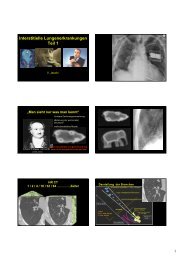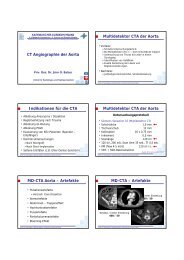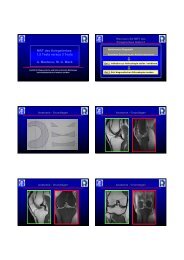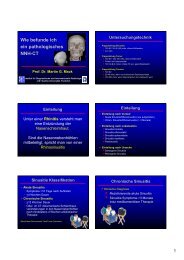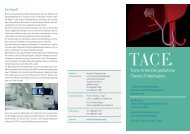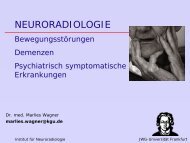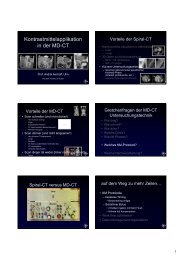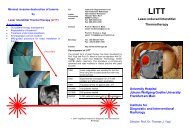und Nachteile der PET-CT
und Nachteile der PET-CT
und Nachteile der PET-CT
Create successful ePaper yourself
Turn your PDF publications into a flip-book with our unique Google optimized e-Paper software.
© Nuclear Medicine<br />
Vor- <strong>und</strong> <strong>Nachteile</strong> <strong>der</strong> <strong>PET</strong>-<strong>CT</strong><br />
Frankfurt, 6. Oktober 2007<br />
Gustav K. von Schulthess, Schulthess,<br />
MD, PhD<br />
Professor <strong>und</strong> Direktor Nuklearmedizin<br />
UniversitätsSpital<br />
Universit tsSpital Zürich rich<br />
Verdankung:<br />
F. Buck; Philipp Kaufmann; Thomas Hany; Hans Steinert;<br />
Klaus Strobel; Katrin Stumpe<br />
Nuclear medicine has been MI all along<br />
Imaging with metabolic spies<br />
Imaging function is more difficult than<br />
imaging anatomy<br />
Medical imaging over the last 500 years<br />
From the anatomy of the dead to bone<br />
metabolism in the living<br />
Anatomic framing of functional information<br />
Software fusion is readily accomplished in the brain, brain,<br />
but not so easily in the body<br />
Brain: SW integration easy Brain: HW integration better<br />
© Nuclear Medicine<br />
Once <strong>PET</strong> (SPE<strong>CT</strong>) is anatomically referenced,<br />
comparision of different studies easy<br />
Inhalt<br />
1. Gr<strong>und</strong>züge Gr<strong>und</strong>z ge Molecular Imaging <strong>und</strong> <strong>PET</strong>-<strong>CT</strong> <strong>PET</strong> <strong>CT</strong><br />
2. Technik: Vor- Vor <strong>und</strong> <strong>Nachteile</strong><br />
3. Klinik: Vorteile<br />
4. <strong>CT</strong> Kontrastmittel in <strong>der</strong> <strong>PET</strong>-<strong>CT</strong> <strong>PET</strong> <strong>CT</strong><br />
5. Klinik: <strong>Nachteile</strong> <strong>und</strong> mögliche m gliche Verbesserungen<br />
© Nuclear Medicine<br />
„contrast contrast agent“ agent sensitivity in imaging<br />
only nuclear (and optical) optical)<br />
imaging have the sensitivity<br />
Imaging- „contrast agent“- spatial/temporal<br />
method concentration resolution<br />
(mol/kg kg) mm/sec<br />
Sono 10-3 1 / 0.01<br />
<strong>CT</strong> 10-3 0.6 / 0.1<br />
Conventional NM 10 -9- 10 -12 12 10 / 1<br />
<strong>PET</strong> 10 -9- 10 -12 12 5 / 5<br />
MRI 10-5 0.1-1 / 0.05-0.2<br />
MRS 10-5 10 / 100<br />
(optical optical imaging 10 -9- 10 -12 12 )<br />
© Nuclear Medicine<br />
Hardware o<strong>der</strong> Software-Integration?<br />
Software Integration?<br />
LAD-Stenose<br />
LAD Stenose<br />
© Nuclear Medicine<br />
1
Inhalt<br />
1. Gr<strong>und</strong>züge Gr<strong>und</strong>z ge Molecular Imaging <strong>und</strong> <strong>PET</strong>-<strong>CT</strong> <strong>PET</strong> <strong>CT</strong><br />
2. Technik: Vor- Vor <strong>und</strong> <strong>Nachteile</strong><br />
3. Klinik: Vorteile<br />
4. <strong>CT</strong> Kontrastmittel in <strong>der</strong> <strong>PET</strong>-<strong>CT</strong> <strong>PET</strong> <strong>CT</strong><br />
5. Klinik: <strong>Nachteile</strong> <strong>und</strong> mögliche m gliche Verbesserungen<br />
© Nuclear Medicine<br />
Technik: <strong>Nachteile</strong><br />
1. Ionisierende Strahlung<br />
- FDG-<strong>PET</strong> FDG <strong>PET</strong> ca. 10 mSv<br />
- low dose <strong>CT</strong> ca. 1-2 1 2 mSv<br />
2. Räumliche umliche Auflösung Aufl sung<br />
3. <strong>PET</strong>- <strong>PET</strong> <strong>und</strong> <strong>CT</strong>-System <strong>CT</strong> System „blockieren blockieren“ sich gegenseitig<br />
- Problem aller „dual dual-modality modality“ Systeme<br />
4. Spezifität Spezifit t von FDG (ebenfalls Entzündungen)<br />
Entz ndungen)<br />
5. Kosten<br />
© Nuclear Medicine<br />
<strong>PET</strong> adds sensitivity to <strong>CT</strong><br />
Goerres GW, Kamel E, Seifert B, Burger C, Buck C, Hany TF,<br />
von Schulthess GK. J Nucl Med 2002; 43:1469-1475.<br />
© Nuclear Medicine<br />
Technik: Vorteile<br />
1. Rascher Untersuchungsablauf<br />
Teilkörper Teilk rper <strong>PET</strong>-<strong>CT</strong> <strong>PET</strong> <strong>CT</strong> Kopf-Os: Kopf Os: < 30 Minuten<br />
2. Flexibilität: Flexibilit t: viele mögliche m gliche Radiopharmaka<br />
3. Anatomische Referenzierung <strong>der</strong> <strong>PET</strong>-Info <strong>PET</strong> Info<br />
4. „kostenlose kostenlose“ Absorptionskorrektur<br />
-> > konsistente Bil<strong>der</strong><br />
5. Effizienter Radiopharmakaverbrauch<br />
© Nuclear Medicine<br />
Inhalt<br />
1. Gr<strong>und</strong>züge Gr<strong>und</strong>z ge Molecular Imaging <strong>und</strong> <strong>PET</strong>-<strong>CT</strong> <strong>PET</strong> <strong>CT</strong><br />
2. Technik: Vor- Vor <strong>und</strong> <strong>Nachteile</strong><br />
3. Klinik: Vorteile<br />
4. <strong>CT</strong> Kontrastmittel in <strong>der</strong> <strong>PET</strong>-<strong>CT</strong> <strong>PET</strong> <strong>CT</strong><br />
5. Klinik: <strong>Nachteile</strong> <strong>und</strong> mögliche m gliche Verbesserungen<br />
© Nuclear Medicine<br />
3 months<br />
post therapy © Nuclear Medicine<br />
Improved sensitivity of <strong>PET</strong>-<strong>CT</strong> <strong>PET</strong> <strong>CT</strong><br />
We know that <strong>CT</strong> misses lesions<br />
<strong>PET</strong> needs no arrow, arrow,<br />
it is the arrow !<br />
?<br />
2
We know that we need to work up bowel foci<br />
Incidence ~3%, aro<strong>und</strong> 2% pre- pre or cancerous lesions<br />
E. Kamel et al., J Nucl Med 2004<br />
© Nuclear Medicine<br />
We know that anatomic referencing is necessary<br />
improved specificity over <strong>PET</strong> for lesion characterization<br />
© Nuclear Medicine<br />
FDG-<strong>PET</strong><br />
F-choline-<strong>PET</strong><br />
<strong>CT</strong> adds specificity to <strong>PET</strong><br />
Is the lesion in the chest or in the liver?<br />
© Nuclear Medicine<br />
<strong>PET</strong> adds specificity to <strong>CT</strong><br />
Improved specificity over <strong>CT</strong> for lesion characterization<br />
© Nuclear Medicine<br />
<strong>CT</strong> adds specificity to <strong>PET</strong><br />
Kamel EM, Goerres GW,. Burger C, von Schulthess GK, Steinert HC.<br />
Radiology 2002; 224:153-158.<br />
© Nuclear Medicine<br />
© Nuclear Medicine<br />
Post-therapeutic Post therapeutic changes:<br />
abnormal muscle tension<br />
<strong>CT</strong> adds specificity of <strong>PET</strong>: other findings<br />
Cause of obstruction seen on <strong>CT</strong> only<br />
obstruction<br />
3
<strong>CT</strong> adds sensitivity to <strong>PET</strong> / limitations<br />
Breast cancer metastases noted on <strong>CT</strong> only<br />
© Nuclear Medicine<br />
Improved T, N staging in NSCL with <strong>PET</strong>/<strong>CT</strong><br />
D. Lardinois, W. We<strong>der</strong>, T.F. Hany, E.M. Kamel, S. Korom, B. Seifert, G.K.<br />
von Schulthess, H.C. Steinert. N Engl J Med. 2003; 348(25):2500-7<br />
50 patients prospectively evaluated<br />
<strong>PET</strong>/<strong>CT</strong> additional information in 41% over <strong>PET</strong> + <strong>CT</strong><br />
T stage Paired Sign Test P-value<br />
<strong>PET</strong>/<strong>CT</strong> vs. <strong>CT</strong> 0.001*<br />
<strong>PET</strong>/<strong>CT</strong> vs. <strong>PET</strong> inverse correlation between<br />
survival and SUV<br />
Data suggest: suggest:<br />
<strong>PET</strong>-<strong>CT</strong> <strong>PET</strong> <strong>CT</strong> improves T Staging in NSCLC<br />
D. Lardinois, W. We<strong>der</strong>, T.F. Hany, E.M. Kamel, S. Korom, B. Seifert,<br />
G.K. von Schulthess, H.C. Steinert. N Engl J Med. 2003; 348(25):2500-7<br />
© Nuclear Medicine<br />
Patient with Hodkin Lymphoma<br />
base line 4x CHOP 8x CHOP after RT<br />
© Nuclear Medicine<br />
Therapy monitoring<br />
<strong>PET</strong> adn <strong>PET</strong>-<strong>CT</strong> <strong>PET</strong> <strong>CT</strong> have prognostic value<br />
© Nuclear Medicine<br />
Substantial clinical data exist on the capability<br />
of <strong>PET</strong> (and <strong>PET</strong>-<strong>CT</strong>) to stratify outcome<br />
- lymphoma<br />
Jerusalem G. Ann Oncol. Oncol.<br />
2003 Jan;14(1):123-30<br />
Jan;14(1):123 30<br />
- gastrointestinal stromal tumors<br />
Goerres GW et al. Europ J NMMI 2005; 32:153-162,<br />
32:153 162,<br />
- non-small cell lung cancer<br />
Mac Manus MP et. al. J Clin Oncol. Oncol.<br />
2003; 21(7):1285-92.<br />
21(7):1285 92.<br />
- rectal cancer<br />
Kalff V et al. J Nucl Med 2006; 47:14-22 47:14 22<br />
- esophageal tumor response<br />
Björn Bj rn LDM et al. Ann Surg 2005; 233:300-309<br />
233:300 309<br />
- differentiated thyroid carcinoma<br />
Robbins et al., J Clin Endocr. Endocr.<br />
Metab 2006; 91: 498–505, 498 505,<br />
4
Inhalt<br />
1. Gr<strong>und</strong>züge Gr<strong>und</strong>z ge Molecular Imaging <strong>und</strong> <strong>PET</strong>-<strong>CT</strong> <strong>PET</strong> <strong>CT</strong><br />
2. Technik: Vor- Vor <strong>und</strong> <strong>Nachteile</strong><br />
3. Klinik: Vorteile<br />
4. <strong>CT</strong> Kontrastmittel in <strong>der</strong> <strong>PET</strong>-<strong>CT</strong> <strong>PET</strong> <strong>CT</strong><br />
5. Klinik: <strong>Nachteile</strong> <strong>und</strong> mögliche m gliche Verbesserungen<br />
© Nuclear Medicine<br />
Limitations of <strong>PET</strong>: <strong>CT</strong> helps sometimes<br />
63 year old male with hypopharyngeal carcinoma<br />
© Nuclear Medicine<br />
Inhalt<br />
© Nuclear Medicine<br />
NSCLC staging of primary tumor<br />
invasion of left pulmonary artery: artery:<br />
need X-ray ray CM<br />
© Nuclear Medicine<br />
Vorteile Klinik<br />
5. One-stop One stop shop<br />
Centrally necrotic lymph node (yellow arrows)<br />
which would not have been recognized as<br />
pathological on <strong>PET</strong> only (red arrow) © Nuclear Medicine<br />
1. Gr<strong>und</strong>züge Gr<strong>und</strong>z ge Molecular Imaging <strong>und</strong> <strong>PET</strong>-<strong>CT</strong> <strong>PET</strong> <strong>CT</strong><br />
2. Technik: Vor- Vor <strong>und</strong> <strong>Nachteile</strong><br />
3. Klinik: Vorteile<br />
4. <strong>CT</strong> Kontrastmittel in <strong>der</strong> <strong>PET</strong>-<strong>CT</strong> <strong>PET</strong> <strong>CT</strong><br />
5. Klinik: <strong>Nachteile</strong> <strong>und</strong> mögliche m gliche Verbesserungen<br />
Note<br />
- <strong>PET</strong>: better delineation of tumor<br />
- CM <strong>CT</strong>: invasion of left PA<br />
- additional findings<br />
1. Höhere here Sens. / Spec. Spec.<br />
als <strong>PET</strong> o<strong>der</strong> <strong>CT</strong> alleine<br />
2. In weiten Bereichen Tu-imaging<br />
Tu imaging MR überlegen berlegen<br />
3. Prognostische Aussagekraft dokumentiert<br />
4. Volle <strong>CT</strong>-Protokolle <strong>CT</strong> Protokolle möglich m glich inkl. KM-<strong>CT</strong>, KM <strong>CT</strong>, Koro-<strong>CT</strong> Koro <strong>CT</strong><br />
<strong>Nachteile</strong> Klinik<br />
1. Ev. eingeschränkte eingeschr nkte Sensitivität Sensitivit t bei osteoblastischen<br />
Knochen-metastasen<br />
Knochen metastasen<br />
2. FDG ist nicht spezifisch für f r Tumoren<br />
3. Substantielle FP Rate bei „Anf Anfängern ngern“<br />
4. <strong>PET</strong> ± bei Prostataca. Prostataca.<br />
<strong>und</strong> an<strong>der</strong>en Tumoren<br />
5. Eingeschränkte Eingeschr nkte Sensitivität Sensitivit t Hirn, Nieren, Blase<br />
© Nuclear Medicine<br />
5
Bronchial carcinoma<br />
Recurrence and persistence of RT field inflammation<br />
© Nuclear Medicine<br />
Patient Hodgkin IIB s. p. ChemoRx and RT<br />
Hany TF, Gharehpapagh E, Kamel EM, Buck A, Himms-Hagen J,<br />
von Schulthess GK. Europ J Nucl Med 2002; 29:1393-1398.<br />
© Nuclear Medicine<br />
Fluoride-<strong>PET</strong><br />
Fluoride <strong>PET</strong>-<strong>CT</strong> <strong>CT</strong><br />
intervertebral and ilio-sacral ilio sacral joint osteo-arthritis<br />
osteo arthritis<br />
© Nuclear Medicine<br />
<strong>PET</strong> and <strong>PET</strong>/<strong>CT</strong> in Osteosynthesis infection<br />
Schiesser M, Stumpe K, Trenz O, Kossmann T, von Schulthess<br />
GK. Radiology 2002; 226:391-398.<br />
226:391 398.<br />
© Nuclear Medicine<br />
Inhalt<br />
© Nuclear Medicine<br />
MIP <strong>CT</strong><br />
bone window<br />
1. Gr<strong>und</strong>züge Gr<strong>und</strong>z ge Molecular Imaging <strong>und</strong> <strong>PET</strong>-<strong>CT</strong> <strong>PET</strong> <strong>CT</strong><br />
2. Technik: Vor- Vor <strong>und</strong> <strong>Nachteile</strong><br />
3. Klinik: Vorteile<br />
4. <strong>CT</strong> Kontrastmittel in <strong>der</strong> <strong>PET</strong>-<strong>CT</strong> <strong>PET</strong> <strong>CT</strong><br />
5. Klinik: <strong>Nachteile</strong> <strong>und</strong> mögliche gliche Verbesserungen<br />
Each tracer is a „new new imaging modality“ modality<br />
Usefulness of various compo<strong>und</strong>s for body imaging ?<br />
FDG F-E-tyrosine F-choline Ga-68 DOTATOC F-thymidine<br />
Bihl, Stuttgart Ell,London<br />
© Nuclear Medicine<br />
6
In-111 In 111 octreotide<br />
Multiple metastases of carcinoid tumor<br />
Courtesy of H. Bihl, Bihl,<br />
Stuttgart<br />
A<br />
B<br />
F<br />
© Nuclear Medicine<br />
Zusammenfassung<br />
1. FDG-<strong>PET</strong> FDG <strong>PET</strong>-<strong>CT</strong> <strong>CT</strong> bringt im Tumorstaging <strong>und</strong> <strong>der</strong><br />
Therapiekontrolle viele Vorteile<br />
2. <strong>PET</strong>-<strong>CT</strong> <strong>PET</strong> <strong>CT</strong> kann mit voll ausgebauten <strong>CT</strong>-Protokollen<br />
<strong>CT</strong> Protokollen<br />
gefahren werden<br />
3. Die <strong>Nachteile</strong> von <strong>PET</strong>-<strong>CT</strong> <strong>PET</strong> <strong>CT</strong> halten sich in Grenzen<br />
© Nuclear Medicine<br />
C,D<br />
E,G<br />
4. An<strong>der</strong>e Radiopharmaka werden neue Diagnostikbereiche<br />
erschliessen <strong>und</strong> einen Teil <strong>der</strong> bestehenden Mängel M ngel<br />
ausmerzen<br />
H,I<br />
Glioblastoma post-op post op<br />
F-ehtyl ehtyl tyrosine <strong>PET</strong>: recurrence?<br />
recurrence<br />
© Nuclear Medicine<br />
7





